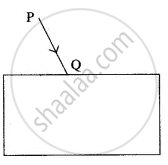Advertisements
Advertisements
प्रश्न
Light of a single colour is passed through a liquid having a piece of glass suspended in it. On changing the temperature of liquid, at a particular temperature, the glass piece is not seen.
Why is the light of a single colour used ?
उत्तर
Light of a single colour is used because the refractive index of a medium (glass or liquid) is different for the light of different colours.
APPEARS IN
संबंधित प्रश्न
State the dependence of angle of deviation On the wavelength of light
The speed of light in glass is 2 × 105 km/s. What is the refractive index of glass?
A ray of light passes from water to air. How does the speed of light change?
How is the reflection of light ray from a plane mirror different from the refraction of light ray as it enters a block of glass?
When light travels from a rarer to a denser medium, its speed ______.
When a ray of light from air enters a denser medium, it ______.
Express the refractive index μ of a medium in terms of the velocity of light.
How does the angle of deviation produced by a prism depend on the colour of light used? Which colour of white light is deviated (i) most, (ii) least, by a prism?
In the diagram below, PQ is a ray of light incident on a rectangular glass block.

Copy the diagram and complete the path of the ray of light through the glass block. In your diagram, mark the angle of incidence by letter ‘i’ and the angle of emergence by the letter ‘e’.
A ray of light PQ is incident normally on the hypotenuse of a right-angled prism ABC as shown in the diagram given below:

(i) Copy the diagram and complete the path of the ray PQ till it emerges from the prism.
(ii) What is the value of the angle of deviation of the ray?
(iii) Name an instrument where this action of the prism is used.
